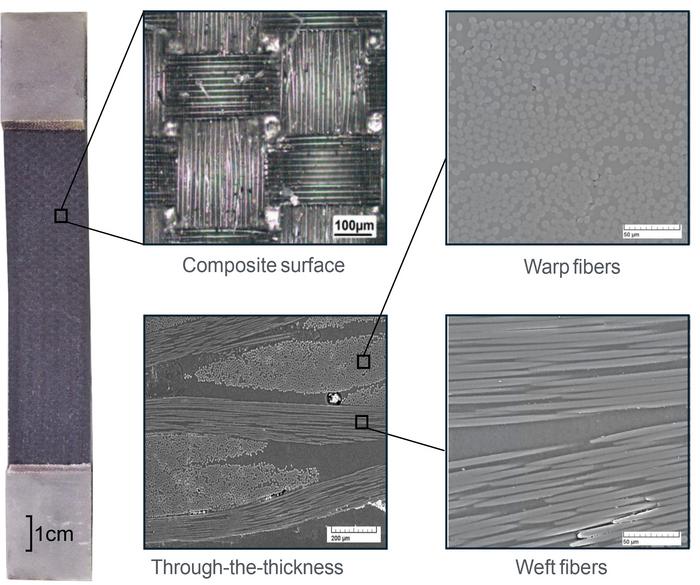In the quest for advancing material science, innovators have long grappled with the challenges inherent in designing new composite materials. These materials, often the synthesis of various compounds such as polymers and carbon fibers, embody a delicate balance of properties—weight, durability, and flexibility being paramount. A recent doctoral thesis from the University of Gothenburg is addressing these hurdles by employing innovative artificial intelligence techniques that could revolutionize how composite materials are developed. This pioneering work, led by PhD student Ehsan Ghane, promises to streamline the time-intensive processes traditionally associated with material design, greatly enhancing the efficiency of creating durable woven composites.
Current methodologies for developing composite materials typically involve exhaustive physical tests and detailed computer simulations. Developers often find themselves entangled in a cycle of trial and error, conducting experiments that can take considerable time, especially when initial models yield subpar results. Each iteration demands not only resources but also significant computational power—an expensive and often impractical limitation for many research projects. Ehsan Ghane shines a spotlight on these bottlenecks, specifically when the composite is intricately woven into a textile fiber structure. The fibers interact in complex ways, underlying the need for a more efficient predictive model.
In Ghane’s research, the focus is on optimizing the predictive power of AI, particularly through generalized machine learning models. These models aim to minimize dependency on extensive datasets that traditional neural networks require. While AI has immense potential for simulating material behaviors, the challenge lies in its need for vast training datasets and its struggle with extrapolating results beyond the data it has encountered. Ghane has responded to these limitations by developing a model that significantly reduces the data required for training while still providing high accuracy in predictions.
.adsslot_2mX7kZ1NL8{ width:728px !important; height:90px !important; }
@media (max-width:1199px) { .adsslot_2mX7kZ1NL8{ width:468px !important; height:60px !important; } }
@media (max-width:767px) { .adsslot_2mX7kZ1NL8{ width:320px !important; height:50px !important; } }
ADVERTISEMENT
One of the critical advancements in Ghane’s approach is the ability to integrate physical material laws directly into the AI framework. This integration allows the model to make educated predictions about material behavior even in scenarios that extend beyond its original training datasets. This is particularly vital for engineers and designers looking to innovate, as understanding how materials may react over extended periods or under unexpected conditions is crucial for durability assessments. Ghane’s model does not just offer predictions; it advances understanding of the deformation order of materials, shedding light on their long-term behavior.
The implications of Ghane’s work extend well beyond the laboratory. Industries that utilize composite materials, from automotive to aerospace, stand to benefit significantly from this research. Efficiently designed composites could lead to lighter, yet stronger materials, enabling advances in everything from wind turbine blades to sports equipment like floorball sticks. The demand for materials that provide optimal performance without excessive weight is more pressing than ever in today’s sustainability-focused market.
Not only does this research advance the frontiers of material science, but it also charts a new path for using interdisciplinary approaches in scientific exploration. By bridging the gap between traditional physics and modern data-driven methodologies, Ghane exemplifies how collaborative efforts across disciplines can yield innovations that were previously thought unattainable. In an era where researchers are relentlessly searching for solutions to complex problems, such pioneering work highlights a promising avenue for future exploration.
Moreover, Ghane’s findings encourage a shift in how we view the relationship between materials and computer modeling. The synergy between empirical data and computational predictions offers an exciting new dimension to material science. Researchers can recreate realistic microstructures of materials, but Ghane’s model introduces an unprecedented level of predictability and efficiency to this process, which has long possessed a level of uncertainty.
For professionals in the field, understanding the intricacies of woven composite materials has now become more approachable, owing largely to this new AI model. By effectively predicting the performance of composites, designers can more confidently embark on new projects, reducing the risks involved in material choice and engineering decisions. With applications ranging from construction to transportation, the potential for this model to redefine industry standards is immense.
In summary, Ehsan Ghane’s significant contribution to composite material science marks a promising step toward overcoming longstanding challenges faced by engineers and material scientists alike. As industries increasingly rely on advanced materials for performance enhancement, this work not only elevates the potential of woven composites but also fosters an environment ripe for innovation. The intersection of artificial intelligence and materials science appears set to usher in a new era of precision, efficiency, and sustainability.
In conclusion, the future of composite material design is at an inflection point, driven by transformative research that seeks to leverage AI’s strengths while mitigating its weaknesses. Researchers can anticipate a new era characterized by enhanced material solutions that meet the evolving demands of various industries, ultimately influencing how composite materials will be conceived and utilized in the years to come.
Subject of Research: Development of AI models for predicting durability and strength of woven composite materials.
Article Title: Learning from Data and Physics for Multiscale Modeling of Woven Composites
News Publication Date: 3-Apr-2025
Web References: Not provided in the content.
References: Not provided in the content.
Image Credits: Credit: Ehsan Ghane
Keywords
Composite materials, AI modeling, material science, woven textiles, durability prediction, artificial intelligence, multiscale modeling.
Tags: advancements in polymer technologyAI in material scienceArtificial Intelligence in engineeringcomposite material developmentefficiency in material synthesisinnovative material design techniquesoptimizing material properties with AIPhD research in compositespredictive modeling for compositesreducing experimental trial and errorrevolutionizing material development processeswoven composite materials





